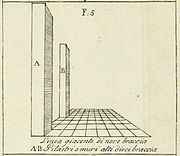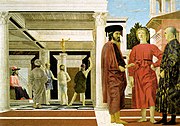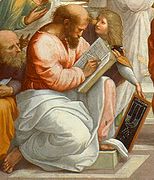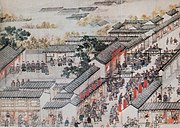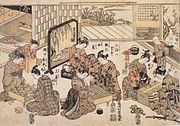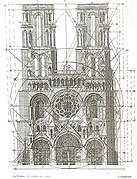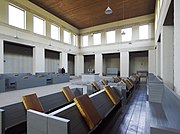Մասնակից:ՆարեԱդամ/Ավազարկղ6

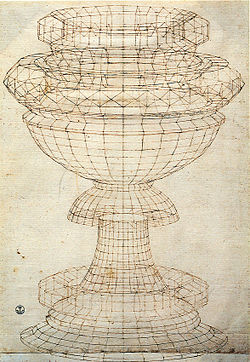
Mathematics and art are related in a variety of ways. Mathematics has itself been described as an art motivated by beauty. Mathematics can be discerned in arts such as music, dance, painting, architecture, sculpture, and textiles. This article focuses, however, on mathematics in the visual arts.
Mathematics and art have a long historical relationship. Artists have used mathematics since the 4th century BC when the Greek sculptor Polykleitos wrote his Canon, prescribing proportions conjectured to have been based on the ratio 1:√2 for the ideal male nude. Persistent popular claims have been made for the use of the golden ratio in ancient art and architecture, without reliable evidence. In the Italian Renaissance, Luca Pacioli wrote the influential treatise De divina proportione (1509), illustrated with woodcuts by Leonardo da Vinci, on the use of the golden ratio in art. Another Italian painter, Piero della Francesca, developed Euclid's ideas on perspective in treatises such as De Prospectiva Pingendi, and in his paintings. The engraver Albrecht Dürer made many references to mathematics in his work Melencolia I. In modern times, the graphic artist M. C. Escher made intensive use of tessellation and hyperbolic geometry, with the help of the mathematician H. S. M. Coxeter, while the De Stijl movement led by Theo van Doesburg and Piet Mondrian explicitly embraced geometrical forms. Mathematics has inspired textile arts such as quilting, knitting, cross-stitch, crochet, embroidery, weaving, Turkish and other carpet-making, as well as kilim. In Islamic art, symmetries are evident in forms as varied as Persian girih and Moroccan zellige tilework, Mughal jali pierced stone screens, and widespread muqarnas vaulting.
Mathematics has directly influenced art with conceptual tools such as linear perspective, the analysis of symmetry, and mathematical objects such as polyhedra and the Möbius strip. Magnus Wenninger creates colourful stellated polyhedra, originally as models for teaching. Mathematical concepts such as recursion and logical paradox can be seen in paintings by René Magritte and in engravings by M. C. Escher. Computer art often makes use of fractals including the Mandelbrot set, and sometimes explores other mathematical objects such as cellular automata. Controversially, the artist David Hockney has argued that artists from the Renaissance onwards made use of the camera lucida to draw precise representations of scenes; the architect Philip Steadman similarly argued that Vermeer used the camera obscura in his distinctively observed paintings.
Other relationships include the algorithmic analysis of artworks by X-ray fluorescence spectroscopy, the finding that traditional batiks from different regions of Java have distinct fractal dimensions, and stimuli to mathematics research, especially Filippo Brunelleschi's theory of perspective, which eventually led to Girard Desargues's projective geometry. A persistent view, based ultimately on the Pythagorean notion of harmony in music, holds that everything was arranged by Number, that God is the geometer of the world, and that therefore the world's geometry is sacred.
Origins: from ancient Greece to the Renaissance
[խմբագրել | խմբագրել կոդը]
Polykleitos's Canon and symmetria
[խմբագրել | խմբագրել կոդը]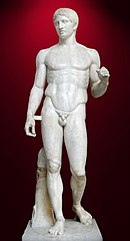
Polykleitos the elder (c. 450–420 BC) was a Greek sculptor from the school of Argos, and a contemporary of Phidias. His works and statues consisted mainly of bronze and were of athletes. According to the philosopher and mathematician Xenocrates, Polykleitos is ranked as one of the most important sculptors of classical antiquity for his work on the Doryphorus and the statue of Hera in the Heraion of Argos.[3] While his sculptures may not be as famous as those of Phidias, they are much admired. In his Canon, a treatise he wrote designed to document the "perfect" body proportions of the male nude, Polykleitos gives us a mathematical approach towards sculpturing the human body.[3]
The Canon itself has been lost but it is conjectured that Polykleitos used a sequence of proportions where each length is that of the diagonal of a square drawn on its predecessor, 1:√2 (about 1:1.4142).[4]
The influence of the Canon of Polykleitos is immense in Classical Greek, Roman, and Renaissance sculpture, with many sculptors following Polykleitos's prescription. While none of Polykleitos's original works survive, Roman copies demonstrate his ideal of physical perfection and mathematical precision. Some scholars argue that Pythagorean thought influenced the Canon of Polykleitos.[5] The Canon applies the basic mathematical concepts of Greek geometry, such as the ratio, proportion, and symmetria (Greek for "harmonious proportions") and turns it into a system capable of describing the human form through a series of continuous geometric progressions.[4]
Perspective and proportion
[խմբագրել | խմբագրել կոդը]
In classical times, rather than making distant figures smaller with linear perspective, painters sized objects and figures according to their thematic importance. In the Middle Ages, some artists used reverse perspective for special emphasis. The Muslim mathematician Alhazen (Ibn al-Haytham) described a theory of optics in his Book of Optics in 1021, but never applied it to art.[6] The Renaissance saw a rebirth of Classical Greek and Roman culture and ideas, among them the study of mathematics to understand nature and the arts. Two major motives drove artists in the late Middle Ages and the Renaissance towards mathematics. First, painters needed to figure out how to depict three-dimensional scenes on a two-dimensional canvas. Second, philosophers and artists alike were convinced that mathematics was the true essence of the physical world and that the entire universe, including the arts, could be explained in geometric terms.[7]
The rudiments of perspective arrived with Giotto (1266/7 – 1337), who attempted to draw in perspective using an algebraic method to determine the placement of distant lines. In 1415, the Italian architect Filippo Brunelleschi and his friend Leon Battista Alberti demonstrated the geometrical method of applying perspective in Florence, using similar triangles as formulated by Euclid, to find the apparent height of distant objects.[8][9] Brunelleschi's own perspective paintings are lost, but Masaccio's painting of the Holy Trinity shows his principles at work.[6][10][11]
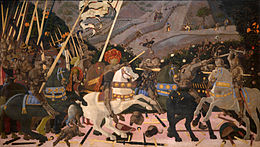
The Italian painter Paolo Uccello (1397–1475) was fascinated by perspective, as shown in his paintings of The Battle of San Romano (c. 1435–1460): broken lances lie conveniently along perspective lines.[12][13]
The painter Piero della Francesca (c. 1415–1492) exemplified this new shift in Italian Renaissance thinking. He was an expert mathematician and geometer, writing books on solid geometry and perspective, including De prospectiva pingendi (On Perspective for Painting), Trattato d'Abaco (Abacus Treatise), and De quinque corporibus regularibus (On the Five Regular Solids).[14][15][16] The historian Vasari in his Lives of the Painters calls Piero the "greatest geometer of his time, or perhaps of any time."[17] Piero's interest in perspective can be seen in his paintings including the Polyptych of Perugia,[18] the San Agostino altarpiece and The Flagellation of Christ. His work on geometry influenced later mathematicians and artists including Luca Pacioli in his De divina proportione and Leonardo da Vinci. Piero studied classical mathematics and the works of Archimedes.[19] He was taught commercial arithmetic in "abacus schools"; his writings are formatted like abacus school textbooks,[20] perhaps including Leonardo Pisano (Fibonacci)'s 1202 Liber Abaci. Linear perspective was just being introduced into the artistic world. Alberti explained in his 1435 De pictura: "light rays travel in straight lines from points in the observed scene to the eye, forming a kind of pyramid with the eye as vertex." A painting constructed with linear perspective is a cross-section of that pyramid.[21]
In De Prospectiva Pingendi, Piero transforms his empirical observations of the way aspects of a figure change with point of view into mathematical proofs. His treatise starts in the vein of Euclid: he defines the point as "the tiniest thing that is possible for the eye to comprehend".[Ն 1][7] He uses deductive logic to lead the reader to the perspective representation of a three-dimensional body.[22]
The artist David Hockney argued in his book Secret Knowledge: Rediscovering the Lost Techniques of the Old Masters that artists started using a camera lucida from the 1420s, resulting in a sudden change in precision and realism, and that this practice was continued by major artists including Ingres, Van Eyck, and Caravaggio.[23] Critics disagree on whether Hockney was correct.[24][25] Similarly, the architect Philip Steadman argued controversially[26] that Vermeer had used a different device, the camera obscura, to help him create his distinctively observed paintings.[27]
In 1509, Luca Pacioli (c. 1447–1517) published De divina proportione on mathematical and artistic proportion, including in the human face. Leonardo da Vinci (1452–1519) illustrated the text with woodcuts of regular solids while he studied under Pacioli in the 1490s. Leonardo's drawings are probably the first illustrations of skeletonic solids.[28] These, such as the rhombicuboctahedron, were among the first to be drawn to demonstrate perspective by being overlaid on top of each other. The work discusses perspective in the works of Piero della Francesca, Melozzo da Forlì, and Marco Palmezzano.[29] Leonardo studied Pacioli's Summa, from which he copied tables of proportions.[30] In Mona Lisa and The Last Supper, Leonardo's work incorporated linear perspective with a vanishing point to provide apparent depth.[31] The Last Supper is constructed in a tight ratio of 12:6:4:3, as is Raphael's The School of Athens, which includes Pythagoras with a tablet of ideal ratios, sacred to the Pythagoreans.[32][33] In Vitruvian Man, Leonardo expressed the ideas of the Roman architect Vitruvius, innovatively showing the male figure twice, and centring him in both a circle and a square.[34]
As early as the 15th century, curvilinear perspective found its way into paintings by artists interested in image distortions. Jan van Eyck's 1434 Arnolfini Portrait contains a convex mirror with reflections of the people in the scene,[35] while Parmigianino's Self-portrait in a Convex Mirror, c. 1523–1524, shows the artist's largely undistorted face at the centre, with a strongly curved background and artist's hand around the edge.[36]
Three-dimensional space can be represented convincingly in art, as in technical drawing, by means other than perspective. Oblique projections, including cavalier perspective (used by French military artists to depict fortifications in the 18th century), were used continuously and ubiquitously by Chinese artists from the first or second centuries until the 18th century. The Chinese acquired the technique from India, which acquired it from Ancient Rome. Oblique projection is seen in Japanese art, such as in the Ukiyo-e paintings of Torii Kiyonaga (1752–1815).[37]
-
Woodcut from Luca Pacioli's 1509 De divina proportione with an equilateral triangle on a human face
-
Camera lucida in use. Scientific American, 1879
-
Illustration of an artist using a camera obscura. 17th century
-
Proportion: Leonardo's Vitruvian Man, c. 1490
-
Brunelleschi's theory of perspective: Masaccio's Trinità, c. 1426–1428, in the Basilica of Santa Maria Novella
-
Diagram from Leon Battista Alberti's 1435 Della Pittura, with pillars in perspective on a grid
-
Linear perspective in Piero della Francesca's Flagellation of Christ, c. 1455–1460
-
Curvilinear perspective: convex mirror in Jan van Eyck's Arnolfini Portrait, 1434
-
Parmigianino, Self-portrait in a Convex Mirror, c. 1523–1524
-
Pythagoras with tablet of ratios, in Raphael's The School of Athens, 1509
-
Oblique projection: Entrance and yard of a yamen. Detail of scroll about Suzhou by Xu Yang, ordered by the Qianlong Emperor. 18th century
-
Oblique projection: women playing Shogi, Go and Ban-sugoroku board games. Painting by Torii Kiyonaga, Japan, c. 1780
Golden ratio
[խմբագրել | խմբագրել կոդը]The golden ratio (roughly equal to 1.618) was known to Euclid.[38] The golden ratio has persistently been claimed[39][40][41][42] in modern times to have been used in art and architecture by the ancients in Egypt, Greece and elsewhere, without reliable evidence.[43] The claim may derive from confusion with "golden mean", which to the Ancient Greeks meant "avoidance of excess in either direction", not a ratio.[43] Pyramidologists since the 19th century have argued on dubious mathematical grounds for the golden ratio in pyramid design. The Parthenon, a 5th-century BC temple in Athens, has been claimed to use the golden ratio in its façade and floor plan,[44][45][46] but these claims too are disproved by measurement.[43] The Great Mosque of Kairouan in Tunisia has similarly been claimed to use the golden ratio in its design,[47] but the ratio does not appear in the original parts of the mosque.[48] The historian of architecture Frederik Macody Lund argued in 1919 that the Cathedral of Chartres (12th century), Notre-Dame of Laon (1157–1205) and Notre Dame de Paris (1160) are designed according to the golden ratio,[49] drawing regulator lines to make his case. Other scholars argue that until Pacioli's work in 1509, the golden ratio was unknown to artists and architects.[50] For example, the height and width of the front of Notre-Dame of Laon have the ratio 8/5 or 1.6, not 1.618. Such Fibonacci ratios quickly become hard to distinguish from the golden ratio.[51] After Pacioli, the golden ratio is more definitely discernible in artworks including Leonardo's Mona Lisa.[52]
Another ratio, the only other morphic number,[53] was named the plastic number in 1928 by the Dutch architect Hans van der Laan (originally named le nombre radiant in French).[54] Its value is the solution of the cubic equation
- ,
an irrational number which is approximately 1.325. According to the architect Richard Padovan, this has characteristic ratios 34 and 17, which govern the limits of human perception in relating one physical size to another. Van der Laan used these ratios when designing the 1967 St. Benedictusberg Abbey church in the Netherlands.[54]
-
Base:hypotenuse(b:a) ratios for the Pyramid of Khufu could be: 1:φ (Kepler triangle), 3:5 (3-4-5 Triangle), or 1:4/π
-
Supposed ratios: Notre-Dame of Laon
-
Golden rectangles superimposed on the Mona Lisa
-
The 1967 St. Benedictusberg Abbey church by Hans van der Laan has plastic ratio proportions.
Տես նաև
[խմբագրել | խմբագրել կոդը]- Mathematics and architecture
- Music and mathematics
Ծանոթագրություններ
[խմբագրել | խմբագրել կոդը]- ↑ Քաղվածելու սխալ՝ Սխալ
<ref>պիտակ՝ «Ziegler» անվանումով ref-երը տեքստ չեն պարունակում: - ↑ 2,0 2,1 Colombo, C.; Del Bimbo, A.; Pernici, F. (2005). «Metric 3D reconstruction and texture acquisition of surfaces of revolution from a single uncalibrated view». IEEE Transactions on Pattern Analysis and Machine Intelligence. 27 (1): 99–114. CiteSeerX 10.1.1.58.8477. doi:10.1109/TPAMI.2005.14. PMID 15628272. S2CID 13387519.
- ↑ 3,0 3,1 Stewart, Andrew (November 1978). «Polykleitos of Argos," One Hundred Greek Sculptors: Their Careers and Extant Works». Journal of Hellenic Studies. 98: 122–131. doi:10.2307/630196. JSTOR 630196. S2CID 162410725.
- ↑ 4,0 4,1 Tobin, Richard (October 1975). «The Canon of Polykleitos». American Journal of Archaeology. 79 (4): 307–321. doi:10.2307/503064. JSTOR 503064. S2CID 191362470.
- ↑ Raven, J. E. (1951). «Polyclitus and Pythagoreanism». Classical Quarterly. 1 (3–4): 147–. doi:10.1017/s0009838800004122. S2CID 170092094.
- ↑ 6,0 6,1 Քաղվածելու սխալ՝ Սխալ
<ref>պիտակ՝ «StAndrews» անվանումով ref-երը տեքստ չեն պարունակում: - ↑ 7,0 7,1 Emmer, Michelle, ed. (2005). The Visual Mind II. MIT Press. ISBN 978-0-262-05048-7.
- ↑ Vasari, Giorgio (1550). Lives of the Artists. Torrentino. էջ Chapter on Brunelleschi.
- ↑ Alberti, Leon Battista; Spencer, John R. (1956) [1435]. On Painting. Yale University Press.
- ↑ Field, J. V. (1997). The Invention of Infinity: Mathematics and Art in the Renaissance. Oxford University Press. ISBN 978-0-19-852394-9.
- ↑ Witcombe, Christopher L. C. E. «Art History Resources». Վերցված է 5 September 2015-ին.
- ↑ Hart, George W. «Polyhedra in Art». Վերցված է 24 June 2015-ին.
- ↑ Cunningham, Lawrence; Reich, John; Fichner-Rathus, Lois (1 January 2014). Culture and Values: A Survey of the Western Humanities. Cengage Learning. էջ 375. ISBN 978-1-285-44932-6. «which illustrate Uccello's fascination with perspective. The jousting combatants engage on a battlefield littered with broken lances that have fallen in a near-grid pattern and are aimed toward a vanishing point somewhere in the distance.»
- ↑ della Francesca, Piero (1942) [c. 1474]. G. Nicco Fasola (ed.). De prospectiva pingendi. Florence.
((cite book)): CS1 սպաս․ location missing publisher (link) - ↑ della Francesca, Piero (1970) [Fifteenth century]. G. Arrighi (ed.). Trattato d'Abaco. Pisa.
((cite book)): CS1 սպաս․ location missing publisher (link) - ↑ della Francesca, Piero (1916). G. Mancini (ed.). L'opera "De corporibus regularibus" di Pietro Franceschi detto della Francesca usurpata da Fra Luca Pacioli.
- ↑ Vasari, Giorgio (1878). G. Milanesi (ed.). Le Opere, volume 2. էջ 490.
- ↑ Zuffi, Stefano (1991). Piero della Francesca. L'Unità – Mondadori Arte. էջ 53.
- ↑ Heath, T. L. (1908). The Thirteen Books of Euclid's Elements. Cambridge University Press. էջ 97.
- ↑ Grendler, P. (1995). M.A. Lavin (ed.). What Piero Learned in School: Fifteenth-Century Vernacular Education. University Press of New England. էջեր 161–176.
((cite book)):|work=ignored (օգնություն) - ↑ Alberti, Leon Battista; Grayson, Cecil (trans.) (1991). Kemp, Martin (ed.). On Painting. Penguin Classics.
- ↑ Peterson, Mark. «The Geometry of Piero della Francesca». «In Book I, after some elementary constructions to introduce the idea of the apparent size of an object being actually its angle subtended at the eye, and referring to Euclid's Elements Books I and VI, and Euclid's Optics, he turns, in Proposition 13, to the representation of a square lying flat on the ground in front of the viewer. What should the artist actually draw? After this, objects are constructed in the square (tilings, for example, to represent a tiled floor), and corresponding objects are constructed in perspective; in Book II prisms are erected over these planar objects, to represent houses, columns, etc.; but the basis of the method is the original square, from which everything else follows.»
- ↑ Hockney, David (2006). Secret Knowledge: Rediscovering the Lost Techniques of the Old Masters. Thames and Hudson. ISBN 978-0-500-28638-8.
- ↑ Van Riper, Frank. «Hockney's 'Lucid' Bomb At the Art Establishment». The Washington Post. Վերցված է 4 September 2015-ին.
- ↑ Marr, Andrew (7 October 2001). «What the eye didn't see». The Guardian. Վերցված է 4 September 2015-ին.
- ↑ Janson, Jonathan (25 April 2003). «An Interview with Philip Steadman». Essential Vermeer. Վերցված է 5 September 2015-ին.
- ↑ Steadman, Philip (2002). Vermeer's Camera: Uncovering the Truth Behind the Masterpieces. Oxford. ISBN 978-0-19-280302-3.
- ↑ Hart, George. «Luca Pacioli's Polyhedra». Վերցված է 13 August 2009-ին.
- ↑ Morris, Roderick Conway (27 January 2006). «Palmezzano's Renaissance:From shadows, painter emerges». New York Times. Վերցված է 22 July 2015-ին.
- ↑ Calter, Paul. «Geometry and Art Unit 1». Dartmouth College. Վերցված է 13 August 2009-ին.
- ↑ Brizio, Anna Maria (1980). Leonardo the Artist. McGraw-Hill. ISBN 9780070079311.
- ↑ Ladwein, Michael (2006). Leonardo Da Vinci, the Last Supper: A Cosmic Drama and an Act of Redemption. Temple Lodge Publishing. էջեր 61–62. ISBN 978-1-902636-75-7.
- ↑ Turner, Richard A. (1992). Inventing Leonardo. Alfred A. Knopf. ISBN 9780679415510.
- ↑ Wolchover, Natalie (31 January 2012). «Did Leonardo da Vinci copy his famous 'Vitruvian Man'?». NBC News. Վերցված է 27 October 2015-ին.
- ↑ Criminisi, A.; Kempz, M.; Kang, S. B. (2004). «Reflections of Reality in Jan van Eyck and Robert Campin» (PDF). Historical Methods. 37 (3): 109–121. doi:10.3200/hmts.37.3.109-122. S2CID 14289312.
- ↑ Cucker, Felipe (2013). Manifold Mirrors: The Crossing Paths of the Arts and Mathematics. Cambridge University Press. էջեր 299–300, 306–307. ISBN 978-0-521-72876-8.
- ↑ Cucker, Felipe (2013). Manifold Mirrors: The Crossing Paths of the Arts and Mathematics. Cambridge University Press. էջեր 269–278. ISBN 978-0-521-72876-8.
- ↑ Joyce, David E. (1996). «Euclid's Elements, Book II, Proposition 11». Clark University. Վերցված է 24 September 2015-ին.
- ↑ Seghers, M. J.; Longacre, J. J.; Destefano, G. A. (1964). «The Golden Proportion and Beauty». Plastic and Reconstructive Surgery. 34 (4): 382–386. doi:10.1097/00006534-196410000-00007. S2CID 70643014.
- ↑ Mainzer, Klaus (1996). Symmetries of Nature: A Handbook for Philosophy of Nature and Science. Walter de Gruyter. էջ 118.
- ↑ «Mathematical properties in ancient theatres and amphitheatres». Արխիվացված է օրիգինալից 15 July 2017-ին. Վերցված է 29 January 2014-ին.
- ↑ «Architecture: Ellipse?». The-Colosseum.net. Վերցված է 29 January 2014-ին.
- ↑ 43,0 43,1 43,2 Markowsky, George (January 1992). «Misconceptions about the Golden Ratio» (PDF). The College Mathematics Journal. 23 (1): 2–19. doi:10.2307/2686193. JSTOR 2686193. Արխիվացված է օրիգինալից (PDF) 2008-04-08-ին. Վերցված է 2015-06-26-ին.
- ↑ Huntley, H.E. (1970). The Divine Proportion. Dover.
- ↑ Hemenway, Priya (2005). Divine Proportion: Phi In Art, Nature, and Science. Sterling. էջ 96.
- ↑ Usvat, Liliana. «Mathematics of the Parthenon». Mathematics Magazine. Վերցված է 24 June 2015-ին.
- ↑ Boussora, Kenza; Mazouz, Said (Spring 2004). «The Use of the Golden Section in the Great Mosque of Kairouan». Nexus Network Journal. 6 (1): 7–16. doi:10.1007/s00004-004-0002-y. «The geometric technique of construction of the golden section seems to have determined the major decisions of the spatial organisation. The golden section appears repeatedly in some part of the building measurements. It is found in the overall proportion of the plan and in the dimensioning of the prayer space, the court and the minaret. The existence of the golden section in some parts of Kairouan mosque indicates that the elements designed and generated with this principle may have been realised at the same period.»
- ↑ Brinkworth, Peter; Scott, Paul (2001). «The Place of Mathematics». Australian Mathematics Teacher. 57 (3): 2.
- ↑ Chanfón Olmos, Carlos (1991). Curso sobre Proporción. Procedimientos reguladors en construcción. Convenio de intercambio Unam–Uady. México – Mérica.
- ↑ Livio, Mario (2002). The Golden Ratio: The Story of Phi, The World's Most Astonishing Number. Bibcode:2002grsp.book.....L. ISBN 9780767908160.
((cite book)):|journal=ignored (օգնություն) - ↑ Smith, Norman A. F. (2001). «Cathedral Studies: Engineering or History» (PDF). Transactions of the Newcomen Society. 73: 95–137. doi:10.1179/tns.2001.005. S2CID 110300481. Արխիվացված է օրիգինալից (PDF) 2015-12-11-ին.
- ↑ McVeigh, Karen (28 December 2009). «Why golden ratio pleases the eye: US academic says he knows art secret». The Guardian. Վերցված է 27 October 2015-ին.
- ↑ Aarts, J.; Fokkink, R.; Kruijtzer, G. (2001). «Morphic numbers» (PDF). Nieuw Arch. Wiskd. 5. 2 (1): 56–58.
- ↑ 54,0 54,1 Padovan, Richard (2002). Williams, Kim; Francisco Rodrigues, Jose (eds.). «Dom Hans van Der Laan and the Plastic Number». Nexus IV: Architecture and Mathematics: 181–193.
Արտաքին հղումներ
[խմբագրել | խմբագրել կոդը]- Bridges Organization conference on connections between art and mathematics
- Bridging the Gap Between Math and Art – Slide Show from Scientific American
- Discovering the Art of Mathematics
- Mathematics and Art – AMS
- Mathematics and Art – Cut-the-Knot
- Mathematical Imagery – American Mathematical Society
- Mathematics in Art and Architecture – National University of Singapore
- Mathematical Art – Virtual Math Museum
- When art and math collide – Science News
- Why the history of maths is also the history of art: Lynn Gamwell in The Guardian
Քաղվածելու սխալ՝ <ref> tags exist for a group named "Ն", but no corresponding <references group="Ն"/> tag was found
Text is available under the CC BY-SA 4.0 license; additional terms may apply.
Images, videos and audio are available under their respective licenses.





